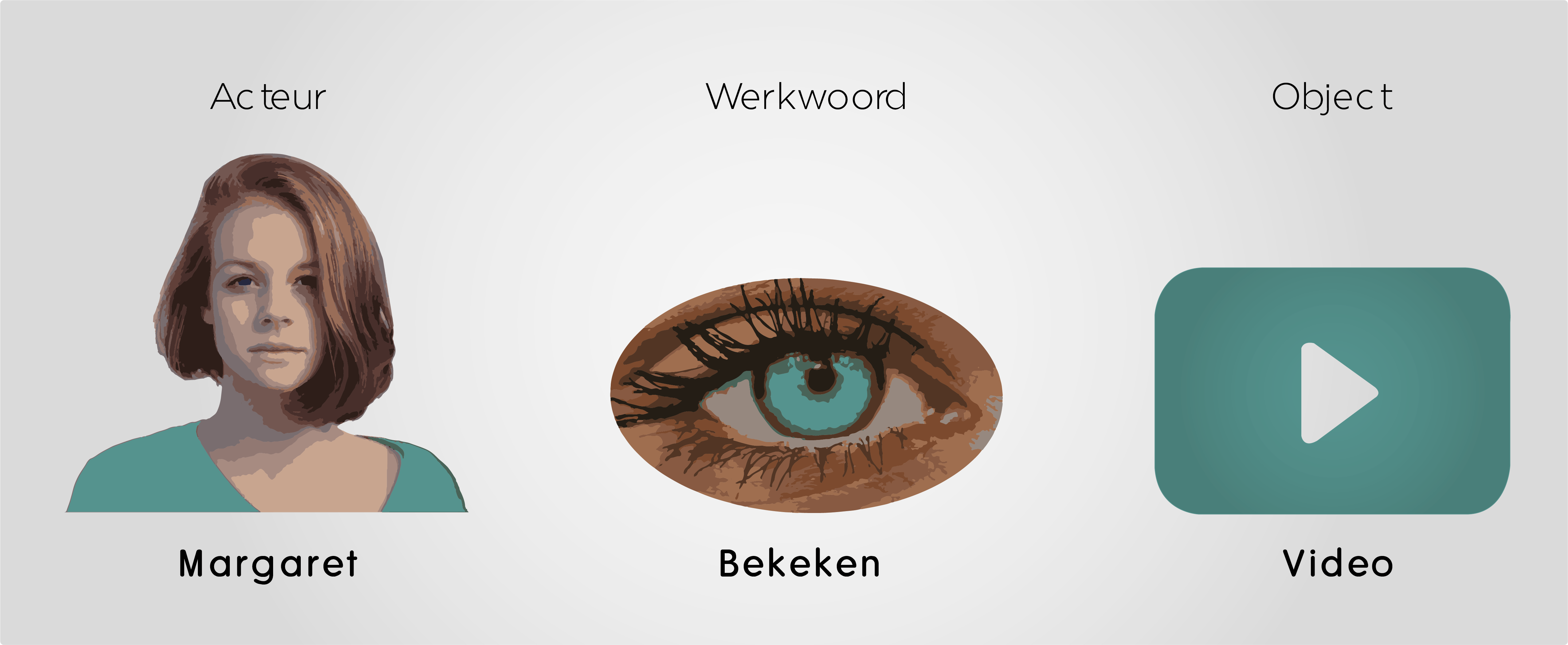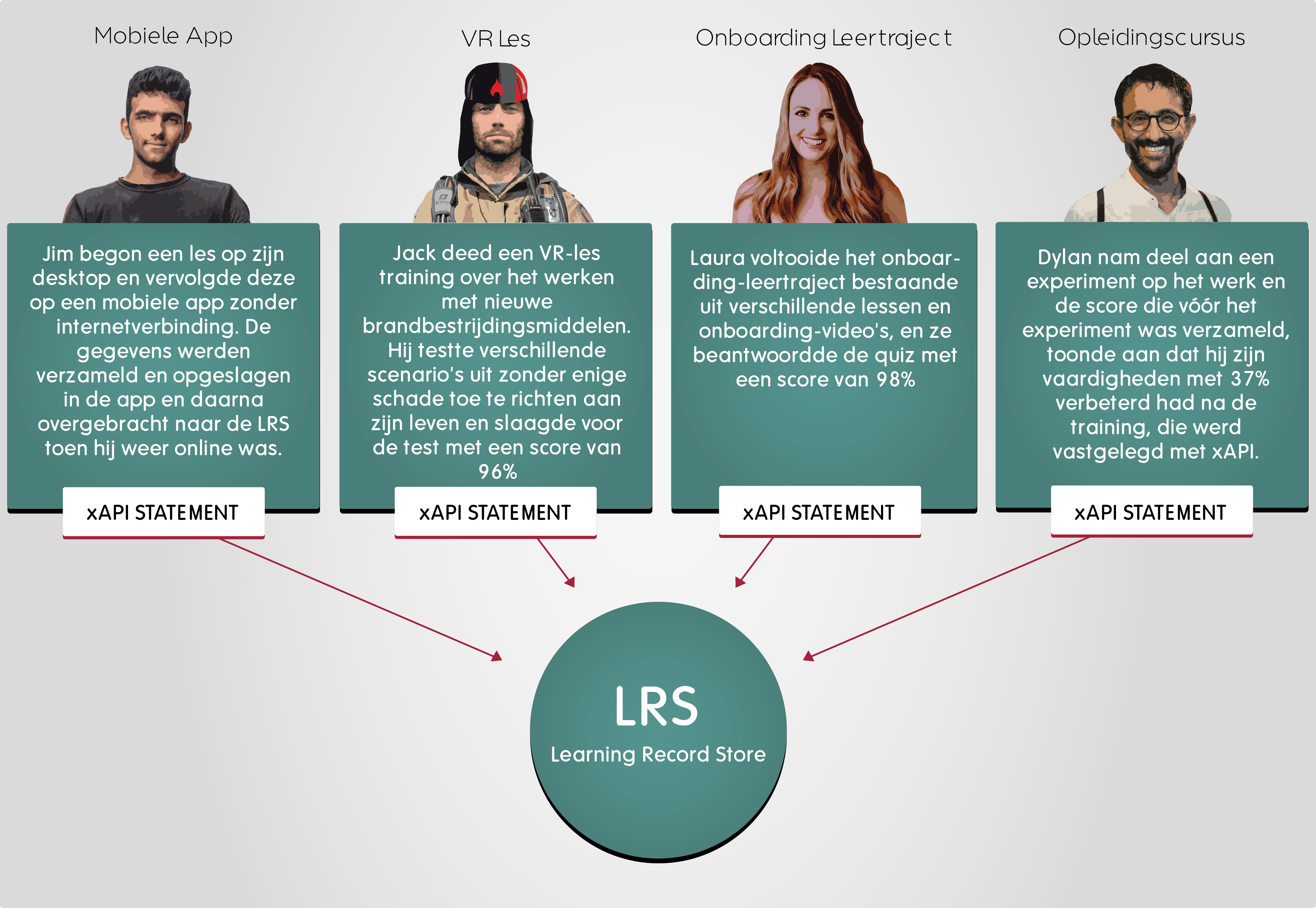Een Learning Record Store, of LRS, is een systeem dat wordt gebruikt in combinatie met xAPI (Experience Applicatie Programming Interface) om leerervaringen van mensen te verzamelen, op te slaan en op te halen. Een LeerOpslagPlaats voor alle mogelijke leeractiviteiten. xAPI is een eLearning-specificatie die het mogelijk maakt om leergegevens uit een breed scala aan bronnen te verzamelen. Soms wordt dit beschreven als het xAPI-ecosysteem.
xAPI is een specificatie die is opgesteld door de organisatie achter SCORM, op basis van ervaringen opgedaan met zowel SCORM als AICC. SCORM is een bestaande standaard voor het maken van online leerpakketten. Hiermee kunnen data worden verzameld als voltooid, geslaagd en een score. Echter in de praktijk is dit wel erg beperkt qua dataverzameling. De wens is er om de resultaten van training en opleiding te kunnen vergelijken of correleren met de resultaten in de praktijk. Maar ook niet alleen de resultaten maar zoveel mogelijk het leerproces zelf. Uiteindelijk gaat leren om iets beter te kunnen doen in de praktijk. Wat heeft iemand gedaan om te leren, en hoe vertaalt zich dat in de praktijk.

Figuur 1. Een leerervaring verklaring
Door de ervaringen van de leerling of verklaringen (Statements) op andere en betere manier op te slaan, namelijk als betekenisvolle verklaringen (xAPI Statements), kunnen de gegevens worden gepresenteerd op een manier die het toegankelijker en gemakkelijker te interpreteren maakt. Het zijn korte grammaticale zinnetjes, waarbij ook nog resultaat, context en tijdstip kan worden vastgelegd. Hierdoor kan bijvoorbeeld makkelijker worden bekeken wat het resultaat is van een specifieke leerinterventie in de praktijk. Bijvoorbeeld bij het trainen van de productkennis van verkopers, heeft dit dan ook een positief effect op de verkoopcijfers.
xAPI gegevens in een Learning Record Store kunnen goed worden vergeleken met bijvoorbeeld gegevens uit een CRM zoals Salesforce of een HRM systeem zoals Peoplesoft. Er heeft een veiligheidstraining plaatsgevonden. Leidt dit ook daadwerkelijk tot minder ongelukken op de werkvloer, over een bepaalde periode bekeken?
Een LRS is een apart systeem dat aan een Leermanagement Systeem (LMS) wordt gekoppeld als dat LMS daarvoor is ingericht. Het ILIAS LMS bijvoorbeeld heeft hier een interface voor en kan zelf ook eenvoudige verklaringen rapporteren. Er zijn een aantal LRS-systemen om uit te kiezen, waaronder:
- Grassblade LRS
- Watershed LRS
- Yet Analytics
- Learning Locker (aanbevolen in combinatie met ILIAS)
Er zijn voldoende opties inmiddels, ook in Open Source of met aanvullende functies tegen betaling. Hetzelfde geldt voor auteurstools. De meeste auteurstools ondersteunen inmiddels ook xAPI, naast SCORM. Daarnaast biedt xAPI de mogelijkheid om bijvoorbeeld te registreren hoeveel iemand heeft bekeken van een video, of hoeveel iemand heeft gelezen van een handleiding, naast afronden van een cursus of behalen van een bepaalde score. Het geeft dus vooral rijkere data die kan worden gebruikt voor bredere en/of diepere analyse van de resultaten. Dus in het LMS kan worden gefilterd op bepaalde verklaringen, maar alle verklaringen komen terecht in het LRS en kunnen daar naderhand worden geanalyseerd of middels bestaande dashboards in meer detail kunnen worden bekeken met drilldowns.
Hoe werkt het?
Een LRS gebruikt xAPI om leergegevens of ervaringen te verzamelen uit zowel online als offline bronnen. Deze ervaringen worden gerapporteerd terug naar de LRS in de vorm van xAPI-instructies, waar ze worden opgeslagen. Deze verklaringen kunnen vervolgens worden opgehaald voor het rapporteren en interpreteren van de leergegevens. Doorgaans biedt een LRS dashboards en rapportagefuncties die speciaal voor deze doeleinden zijn gebouwd.
xAPI genereert instructies in de volgende structuur: [actor/zelfstandig naamwoord] [werkwoord] [object]. Door gebruik te maken van deze structuur wordt de manier waarop leeractiviteiten worden gerapporteerd gestandaardiseerd. Dit maakt het gemakkelijker om gegevens uit veel verschillende bronnen te interpreteren. Zoals een mobiele app, een virtual reality video, een onboarding event of een traditionele cursus.

Figuur 2. Meerdere bronnen voor de LeeRopslagplaatS
Wat is het verschil tussen een LRS en een LMS?
Het belangrijkste verschil tussen deze twee systemen is de LRS is voornamelijk op zijn plaats om xAPI-verklaringen te volgen en op te slaan. Het LMS of LCMS, heeft naast het beheer van al jouw leerbehoeften, leerpaden en eigen rapportages. Het is ook mogelijk om de gegevens van een LMS door te sturen naar een LRS zoals ILIAS dat kan doen. Het is belangrijk op te merken dat een LRS geen vervanging is voor een LMS of vice versa. Ook zijn sommige externe systemen in staat om te koppelen met een LMS via bijvoorbeeld LTI of xAPI, en de gegevens door te sturen naar het LRS. Dit geldt bijvoorbeeld voor een H5P server.
Rapportages
Het is belangrijk op te merken dat sommige LMS-providers LRS functies hebben ingebouwd. Een LRS is niet per se nodig om rapporten te genereren. Dit kan in beperkte mate gedaan worden binnen het LMS. Met het ILIAS LMS is het bijvoorbeeld mogelijk om xAPI-instructies op te slaan, bij te houden, uit te filteren en te rapporteren zonder dat er een Learning Record Store nodig is. Zoals eerder vermeld, kunnen deze verklaringen echter worden doorgestuurd van ILIAS naar uw LRS waar jij de xAPI-gegevens kan rapporteren en analyseren precies zoals jij dat wilt.
Hoewel het inbouwen van een LRS in een LMS mogelijk is, is het het beste, te concentreren op de leer- en cursusinhoud met het LMS. Het beheer van xAPI-gegevens wordt overgelaten aan een LRS systeem dat gespecialiseerd is in dergelijke gegevens. Door deze aanpak te volgen, worden de krachten van beide systemen optimaal benut. Er kan worden gestart met ILIAS en xAPI gegevens, en daarna kan er worden uitgebreid indien nodig en gewenst.
Heeft u een LRS nodig?
Eén van de vragen die met de komst van de LRS gesteld werd is of men er een nodig heeft of niet. Het antwoord op die vraag is afhankelijk van de doelen, doelstellingen en beschikbare middelen. Een LMS en een LRS functioneren binnen hetzelfde leer ecosysteem, maar doen heel verschillende dingen.
In het algemeen is een LRS nodig als er een groot aantal leeractiviteiten zijn uit een veelheid aan bronnen die moeten worden gevolgd. Het verzamelen en vooral het aggreren van al deze activiteiten geef jij de mogelijkheid meer gegevenspunten te analyseren. Het is “big data” voor eLearning. Als jij niet zoveel verschillende leeractiviteiten hebt, zoals bijvoorbeeld een combinatie van mobiel, VR, klassikaal en online, is er wellicht geen behoefte aan een LRS. Behalve als jij de resultaten direct wilt kunnen koppelen aan de effecten in de dagelijkse praktijk op het gebied van verkoop, veiligheid, toegenomen bewustzijn en kennis, etc. Oftewel de heilige graal van het leren: wat kan ik er mee in de praktijk en welk resultaat levert het eigenlijk op. Denk hierbij aan de genomen maatregelen voor corona en het effect op het aantal besmettingen, ziekenhuisopnames etc.
Conclusie
Het heeft alleen zin om te investeren in een LRS als er een groot aantal activiteiten plaatsvindt, of een zeer groot aantal gebruikers bij te houden zijn. Anders genereer jij niet genoeg gegevens om een zinvolle analyse mogelijk te maken. Als dit wel het geval is dan kan jij statistieken genereren die daadwerkelijk kunnen voorspellen wat het effect is van leerinterventies en kennisoverdracht. Denk hierbij aan het trainen van nieuwe medewerkers, toename van kwaliteit op basis van toegenomen kennis en vaardigheden, maar ook een meer diepgaande klantkennis voor marketing doeleinden. Al deze scenario’s komt Future Learning in de praktijk van het leren ondersteund door technologie wel tegen.
In 2021 zullen wij ook verder gaan met de mogelijkheden van xAPi en LRS en hieromtrent workshops en sessies organiseren, waardoor jij het nut er van in de dagelijkse praktijk concreet kunt bekijken.


Recent Comments